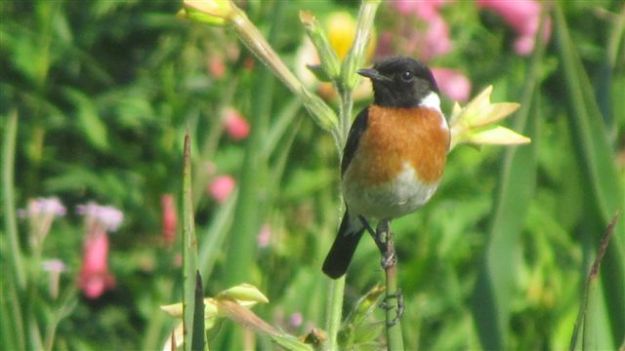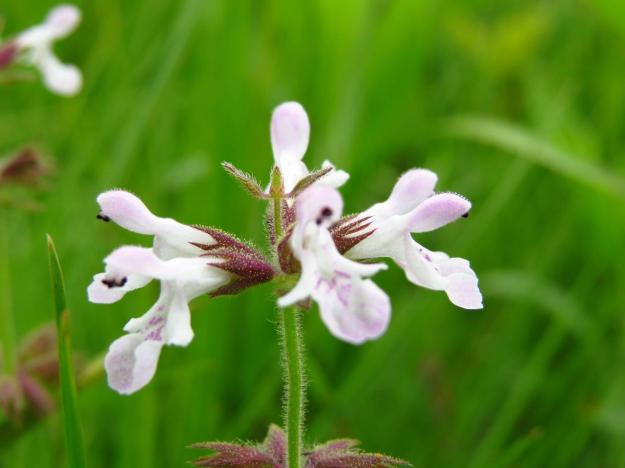Marashene Lewis – Glen Gyle
I took the photograph one morning from our guest bedroom upstairs. The view is looking towards the D707 as it meandered down the hill to join the D17.
Helen Booysen – Kilgobbin Cottage
Came across this large snail up in the hills on Carlisle,
and spotted this beautiful moth on the same walk.
Andrew Pridgeon – Copperleigh Farm
Saw a Water Mongoose cross the road just before the entrance gate to the farm. Di Droste photographed this:
Pat McKrill’s Comment: “Your snake is a rinkhals – looks like a juvenile with attitude. You’ll find a few colour and pattern variations around that might lead to a bit of confusion, but the basic jizz of the variegated version shown in your pic is diagnostic.”
Pat and Sandra Merrick – Albury Farm
Another month of misty grey days. I am always alerted by the special cry of the fish eagles as they fly overhead. Seen them high in the sky at least 4 times in past month. A pair of red necked francolin woke us at 5am one morning but ran into the shrubs before I could get a picture. The secretary bird walking the hills on a few occasions and also seen flying over farm. Common Stone chats are common.
Hundreds of white butterflies flew into the garden on the 30th November and there were also dozens of dragon flies on the same day, so the swallows were having a field day.
A handful of white stork arrived on the 1st december and they are still here in the lands. Don’t know what happened to the rest of them. All the widow birds left end of november. Only one lonely chap left.
Our 2 wagtail babies left the nest on the 27th november and decided to shelter in my miniature rose bushes in front of the house, where mom fed them for about a week, before they started venturing forth to find their own food. 
One afternoon they both found a worm and rushed into the roses, only to rush out again being chased by an olive thrush. She loves going in there to pick up frogs as our water feature is also there and an attraction for the frogs. They now fly around the garden and love hopping in and out of the rocks looking for insects.
We had 2 cape canaries laying last month. One in the standard rose and the other in a standard duranta. One lot hatched out on the 9th dec with 2 babies and the other one on the 10th dec with 2 babies. Unfortunately on the 16th dec I found that my standard roses braches were broken, and a tattered nest with no week old babies. There were no prints below the rose, so I can only presume that a gymnogene had taken them. The other 2 babies are doing fine so far except that my cat is intrigued by the cheeping.
A grey heron came to visit in the garden one morning.
Pat saw one of the sparrow hawks eating a bird in the pastures. Lots of red billed Queleas around.
One afternoon a small baby jackal, still with its fluffy hair ran in front of the car and into the wattle plantation on our farm. Saw 2 duiker in a chase across the hills.
One morning saw a mother oribi and her young male son running across the hill in front of the house.
A black sunbird and his mate are building a nest which looks almost complete, on the glass shade of our verandah.
Every few days the Steppe buzzard comes and perches on our dead tree next to the pond.
Saw a grey mongoose running around the D18 at midday – Don’t see them much during the day. The birds all seem very busy nesting or finding food for their young – all in a great hurry. Cape Robin in my formal garden with a whole clump of something in its beak.
Ashley Crookes – Copperleigh Farm
Luckily a cellphone is always on hand (well, except in extreme situations when you actually really need them…) so I managed to capture a few locusts this month on the farm.
Nikki Brighton – Old Kilgobbin Farm
I like looking up. You always see something interesting. This month, African spoonbill, Grey Heron, lots of Spurwinged Geese, Jackal Buzzards, Swallows, Cormorants, Knysna Turacos, Crowned and Blue Cranes have flown over my head. I was delighted to see a Blue Crane at ground level too.
Once my gaze shifted from the sky to the earth there were so many summer delights at ground level. Only one in six plants in healthy grassland are actually grasses, perfectly illustrated by this selection.Satyrium longicauda,
Kouhoutia amatymbica,
Dipcadi viride,
Eulophia foliosa,
Ajuga,
Anthericum,
Aristea,
Cephalaria oblongifolia,
Cyanotis speciosa,
Cyphia longifolia,
Diclis reptans,
Hypericum lalandii,
Lobelia erinus,
Pentanisia,
Rhodohypoxis baurii,
Scilla nervosa,
Senecio (discodregeanus?),
Silene bellidoides,
Trachyandra,
Tulbaghia natalensis,
Psammotropha mucronata,
Senecio oxyriifolius,
Sisyanthus trichostomus,
Vernonia hirsuta,
Senecio setosa,
Hermannia depressa,
Hypoxis parvula,
Zantedeschia albomaculata,
Hibiscus trionum,
Ledebouria,
Hesperantha baurii,
Gerbera ambigua.
Two new exciting finds I never seen on the farm before were: Psorolea abottii and
Knipophia breviflorus (if I have the id correct, that is!)
Although this photo of Stachys aethiopica is out of focus, I had to include it – just look at those hairs on the stem. Isn’t it fun when you download your photos and discover a whole lot of interesting things you never realised were there in the field?
Saw two Bushbuck, a few Common Duiker and a couple of Scrub Hares, big troops of Samango monkeys and 8 Reedbuck.
Heard tree dassies, jackals, Wood Owls, Barn Owls, Burchell’s Coucal, Buff spotted Flufftail, African Cuckoo, Red Chested Cuckoo. Am thoroughly enjoying watching Weavers build their nests right outside my kitchen door – so fast and such enthusiasm!
There seem to be masses of insects about, pollinating everything in flower. Loved this gorgeous wasp on Vernonia.
























































Such a wonderful series of photos. Thanks and congratulations to all these reporters and camera enthusiasts. It brings a breath of life to our staid world. Please never stop this super record of real daily life
LikeLike
I totally agree with David Clulow’s comment. I am so happy to have a few of these flowers in my Westville garden – it is exciting to recognise names and flowers; learning all the time. Thank you.
LikeLike